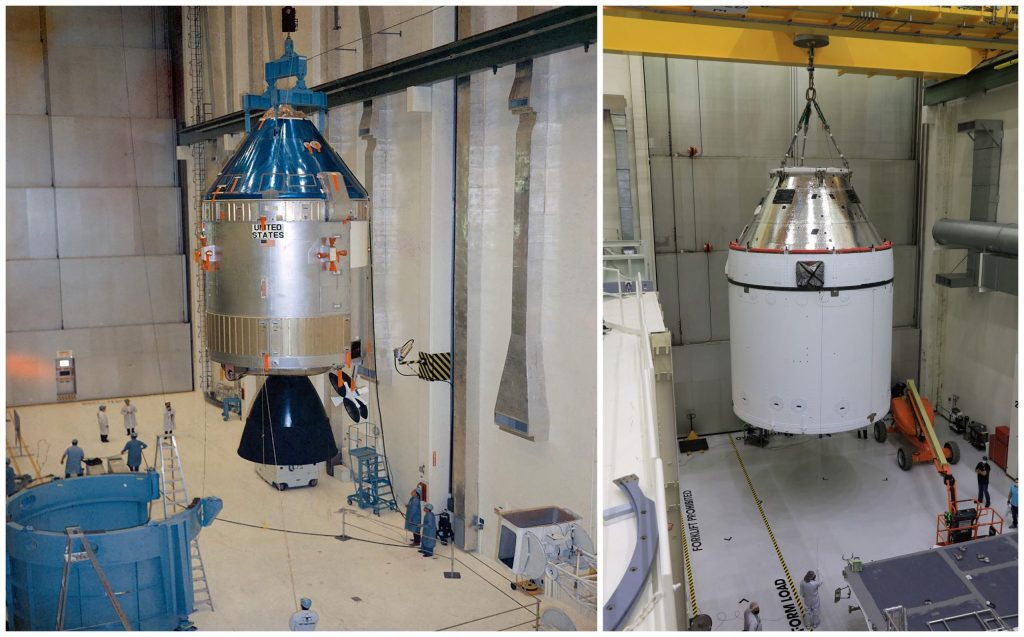In our newest blog series, we are exploring the uncrewed Artemis I flight, a mission that will pave the way for future lunar exploration.
NASA learned an enormous amount from the Apollo missions. All that invaluable knowledge has been put to good use in planning a return to the Moon with the upcoming Artemis flights.
Artemis is the Apollo of this generation. Those who weren’t alive to witness the first person step foot on the Moon will soon have their own opportunity to witness a live lunar landing.
As we look forward to humanity’s return to the lunar surface, we remember the lunar landings that came first, paving the way for future lunar exploration and inspiring the Artemis generation.
Last time in this series, we shared about Orion, NASA’s next generation spacecraft. This week, we are exploring a few of the key differences between NASA’s two lunar programs. Although Apollo and Artemis share similarities, they also have distinct differences.
-
Spacecraft and crew size
One significant difference between Orion and the Apollo command modules is their crew capacity. While the Apollo command modules (left below) carried a crew of three, the larger Orion spacecraft (right below) will carry one extra crew member for a total of four Artemis astronauts. The Apollo command modules had a habitable volume of approximately 210 cubic feet. That will increase to a habitable volume of roughly 316 cubic feet in the Orion spacecraft. This extra space allows for the accommodation of an extra crew member.

-
Rockets
Apollo had the mighty Saturn V. Artemis has the even mightier Space Launch System (SLS). It might be hard to imagine a rocket even more powerful than the Saturn V that launched men to the Moon, but NASA’s SLS will be. The SLS will be powered by a core stage (the tallest rocket stage in the world) flanked by two solid rocket boosters, and an upper stage called the Interim Cryogenic Propulsion Stage. This is a different setup than the Saturn V’s three rocket stages. The SLS will generate 15 percent more thrust than Apollo’s Saturn V, and will launch Artemis astronauts on missions to the Moon, Mars, and beyond.
-
Distance
Orion is designed and built to travel farther than the Apollo capsules. While the Moon was the final stop for the Apollo spacecraft, it is the first stop for Orion, which will eventually travel beyond the Moon to Mars. Even with the uncrewed Artemis I mission, Orion will surpass the Apollo command modules by traveling 40,000 miles past the Moon, the farthest a spacecraft designed to safely carry humans will have ever traveled.
-
Technology
It’s no surprise that the technology in Orion is more advanced than the Apollo spacecraft. Unlike the Apollo capsule’s single flight computer, Orion is equipped with two redundant flight computers that operate simultaneously, and are each themselves equipped with two redundant computers, totaling four redundant systems. Orion’s computers hold significantly more memory and operate at much faster speeds than an Apollo-era computer. In fact, NASA reports that Orion’s computer operates 20,000 times faster and the memory capacity is 128,000 times greater.
-
Goals
In the ’60s, America was involved in a space race with the Soviet Union. Getting to the Moon was more political than scientific. The Apollo-era was also fast-paced, with half a dozen lunar landings taking place over four years. Unlike the brief Apollo visits, the Artemis missions are attempting to establish a more continuous presence on the Moon via longer duration missions, and the creation of lunar bases and an orbital gateway.
While Apollo astronauts did conduct experiments and collect lunar samples, Artemis missions will have a more significant focus on science investigations and exploration. Another key focus will be on developing a lunar economy, as well as cultivating the necessary skills and technologies required to push farther to Mars and beyond. These missions would also serve as inspiration for a whole new generation of deep-space explorers.
-
Commercial partners
Companies are more involved than ever in human space exploration, and the Artemis program is no exception. Commercial partners are heavily involved in the Artemis program. They support NASA’s next giant leap with risk mitigation, spacesuit design, and even the development of lunar landers and rovers.
-
The first woman and person of color to set foot on the Moon
The Apollo missions saw no woman or person of color step foot on the Moon. With the Artemis flights, NASA has pledged to put the first woman and person of color on the Moon. Take a look at NASA’s first digital, interactive graphic novel which was recently released on National Comic Book Day, in the video below. The imaginative story follows the journey of the first woman to set foot on the Moon (see below). Read and interact with the story here.








